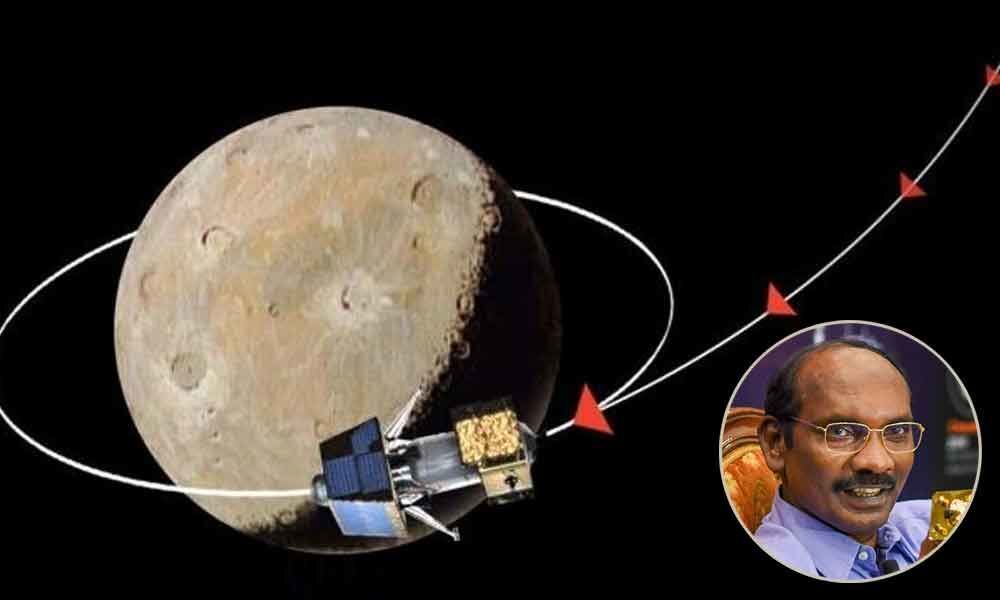Chandrayaan-2 enters Moon orbit

spacecraft To land on Moon at 1.55 am on Sept 7
Sriharikota: The Indian Space Research Organisation (Isro) has successfully guided Chandrayaan-2 into an elliptical orbit around Moon. After a few more manoeuvres, the lander (Vikram) is expected to touch down on the lunar surface at 1.55am on September 7.
Right now, Chandrayaan-2 is an integrated spacecraft comprising the orbiter on which Vikram is attached. Vikram, in turn, has inside it Pragyan (rover), which is expected to roll out about four hours after the lunar landing.
Speaking after the 'lunar orbit insertion' (LOI) that put Chandrayaan-2 in a 114km x 18,072km orbit around Moon, Isro chairman K Sivan, said: "We've crossed another milestone. A precise LOI put Chandrayaan-2 in the desired orbit perfectly."
He said in order to achieve the soft-landing on September 7, the spacecraft should achieve an inclination of 90°; as of Tuesday, Chandrayaan-2 has an inclination of 88°. The space agency will now perform four more manoeuvres – on August 21, 28, 30 and September 1 – to take the spacecraft to lower orbits.
AUGUST 21
On August 21, Chandrayaan-2 will perform a manoeuvre to lower its orbit around the Moon. Between 12:30 pm and 1:30 pm, the Chandrayaan-2's onboard propulsion system will be used to descend slightly towards the Moon.
Once the manoeuvre is successfully completed, Chandrayaan-2 will be in an elliptical orbit of 121 kms x 4303 kms -- the probe will be 121 kms away from the Moon at the orbit's nearest point and 4,303 kms away at its farthest point.
AUGUST 28
A week after the first orbit manoeuvre, Chandrayaan-2 will perform another similar manoeuvre. This manoeuvre will be performed between 5:30 am and 6:30 am on August 28 and will place the spacecraft into an elliptical orbit of 178 kms x 1,411 kms around the Moon.
AUGUST 30
On August 30, Chandrayaan-2 will perform its penultimate orbit manoeuvre around the Moon. This manoeuvre will be performed between 6 pm and 7 pm.
Once the August 30 manoeuvre is completed successfully, Chandrayaan-2 will be in an elliptical orbit of 126 kms x 164 kms.
SEPTEMBER 1
By the night of September 1, Chandrayaan-2 will be closest to the Moon. Between 6 pm and 7 pm, an orbit manoeuvre will bring Chandrayaan-2 into a near-circular orbit around the Moon.
At the closest point, Chandrayaan-2 will be 114 kms away from the lunar surface while at the farthest point it will be 128 kms away from the Moon.
SEPTEMBER 2
September 2 is the D-Day for the Chandrayaan-2 mission. On this day, the lander Vikram will separate from the Chandrayaan-2 spacecraft and get into an orbit of its own around the Moon. The lander Vikram houses the six-wheeled rover Pragyaan that will explore the lunar surface.
SEPTEMBER 3
On September 3, Isro will carry out a three-second manoeuvre to check that the lander Vikram is in good health.
SEPTEMBER 4
A day later, the lander Vikram will perform a manoeuvre to lower its orbit around the Moon. Once successful, the manoeuvre will place the lander in an elliptical orbit of 35 kms x 97 kms around the Moon.
Over the next three days, the Isro will keep checking the parameters of the lander to make sure that everything is a-okay.
SEPTEMBER 7
On September 7, at 1:40 am, the "15 minutes of terror" for the Isro scientists back home will begin. The lander Vikram will begin its powered descent on to the surface of the Moon.
Vikram will be attempting what no other country has been able to successfully to do -- perform a 'soft landing' near the south pole of the Moon.
1:55 am: After 15 minutes of a powered descent, Vikram will land on the Moon. Vikram will land near the lunar south pole, 71 degrees to south of equator and 22.8 degrees east.
3:55 am: Around two hours after landing, Vikram's ramp will open, allowing the six-wheeled rover Pragyaan to come out.
5:05 am: Pragyaan will deploy its solar panels, which will use solar energy to power the many systems on board the rover.
5:10 am: Pragyaan will begin moving around on the lunar surface. Its mission life is for one lunar day, which is equivalent to two weeks on Earth.

















